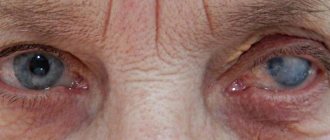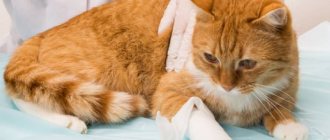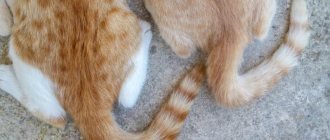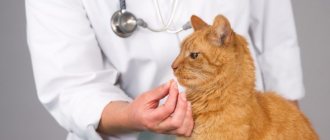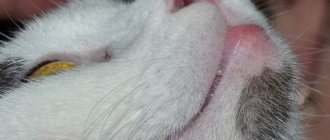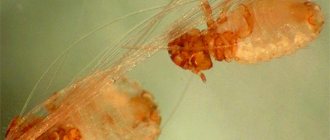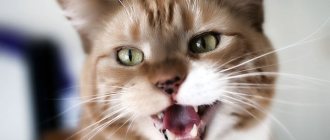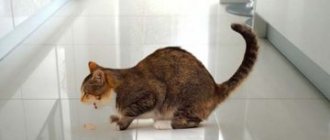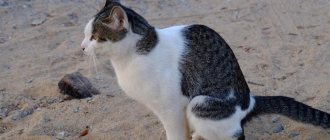Home » Useful Information
The swelling of a cat's lower lip has relatively harmless reasons - a mild allergy to food or an insect bite, scratching, a scratch received in a fight, etc. In this case, removing the swelling is quite simple - the main thing is to start therapy on time, without leading to complications. The situation is more difficult when the inflamed lip is a symptom of dangerous pathologies (including oncology), which require long-term complex treatment.
- 2 How to diagnose the cause
- 3 What to do if your cat has a swollen lower lip
Possible reasons
Often, even attentive owners do not immediately notice a swelling on the lip. Having discovered it, the question arises as to what is the reason why the cat’s lower lip is swollen.
© shutterstock
The most common reasons why cats may have a swollen lower lip:
- Introduction of dry food into the diet . Cats may develop a callus on their lower lip due to the unusual consistency of the food. Hard granules rub the lip, and this leads to swelling.
- Trauma . A cat can injure its lower lip during active play. This can happen either during a fall from a height, or when colliding with objects, or when trying to chew on a hard toy.
- Bite of another animal . This happens quite often if the cat is outdoors, where it comes into contact with other animals. This can also happen if, in addition to the cat, other pets live in the house. Animal games can be quite active and aggressive.
- Insect bite . A cat can be bitten by various insects - bees, wasps, horseflies.
- Allergic reaction . A cat can be allergic to different things. It can occur due to contact with household chemicals, flowers, plants, new food and various other irritants. Various parasites can also be the cause: helminths, fleas and ticks.
- Viral infection . It is expressed in the presence of small blisters on the oral mucosa that may resemble herpes.
- Tumor or cyst of the salivary glands . Occurs due to injury to the salivary glands. This may occur due to injury to the lower lip.
- Malignant tumor . Cancer can affect any tissue in the mouth. It can also affect the lower lip. The swollen lip will feel hard to the touch.
- Acne . You may notice black dots on a swollen lip. They are often accompanied by the presence of small pimples. When the disease is advanced, crusts, inflammation, ulcers, nodules, and extensive redness can be observed on the lower lip and chin. When touched, pain may occur.
How to fix the problem
If the cause of the swelling is a callus due to a change in food, then it is enough to switch the pet to liquid food for a while. In this case, no additional treatment is required. If a cyst is present, it can be removed in a veterinary clinic.
If your pet has injured its lip, the affected area should be treated with antiseptics 3 times a day. A solution of Chlorhexidine is suitable for these purposes. It is not recommended to use drugs containing alcohol, as they can increase pain. The course of treatment depends on the nature of the injury.
Chlorhexidine has an antiseptic effect
If your cat's lip is swollen due to an insect bite, you should immediately apply a cool compress. Then carefully examine the affected area and, if necessary, remove the sting with tweezers. Just in case, it is recommended to give your pet any antihistamine: Suprastin, Zodak, etc. A quarter of a tablet is enough, which should first be crushed and mixed with water.
Suprastin eliminates the symptoms of an allergic reaction
If there is a burn, long-term rehabilitation therapy is required. For these purposes, it is recommended to use ointments such as Panthenol, Sulfargin and others. They need to be applied 2 times a day for a week or more. For allergies, antihistamines are used regularly. It is also important to identify the cause and eliminate it.
Panthenol accelerates the healing of damaged tissues
Eosinophilic granuloma is treated with a complex of antibiotics (Doxycycline, Amoxicillin, etc.), as well as glucocorticosteroids (Dexamethasone and Hydrocortisone). The drugs have a strong effect on the body, so the course and dosage are determined only by the doctor.
Dexamethasone eliminates swelling
A viral infection is eliminated with the help of immunostimulants: Ribaflox, Fosprenil, Interferon, etc. If the cause of swelling is fungal flora, then Fungivet, YAM ointment, etc. are prescribed. These drugs are used in a course of at least 10–14 days.
YAM ointment is active against fungal flora
Attention! Antiviral, antibacterial and antifungal medications should not be used without consulting a doctor. Only he can determine the correct dosage.
How to cure a kitten
To eliminate swelling of the lower lip in a kitten, treatment is the same as for adult pets. The only difference is that all drugs are used in reduced dosages. Therapeutic tactics directly depend on the provoking factor. For treatment, only local agents are often used: antifungal, antiseptic, antiviral and antibacterial.
To eliminate swelling of your pet’s lower lip, you need to contact a veterinarian in time. This is especially important when treating kittens, since the baby’s body during the growth period is still very weak and susceptible to various infections. An integrated approach to therapy allows you to eliminate the cause of the problem and relieve your pet of unpleasant symptoms.
Associated symptoms
If a cat's lower lip is swollen, then this in itself is a symptom of various kinds of pathological processes in the body. However, in most cases, if the lip is swollen, it happens for completely harmless reasons. You should be wary only if there are accompanying negative signs.
Alarming symptoms:
- hard swelling structure;
- increased body temperature;
- lack of appetite;
- discharge of pus;
- blisters on the mucous membrane;
- the lip turned red;
- significant swelling;
- bad breath;
- spread of the tumor to surrounding tissues;
- discharge from the eyes and nose.
© shutterstock
Periodontal disease
Symptoms:
- Bad breath. One of the main reasons for visiting a veterinarian. The smell from the mouth becomes unbearable, putrid in nature, and can be felt from afar (when the animal enters the room).
- Decreased appetite. The cat wants to eat, but cannot. Refuses the once-favorite “crackers”, preferring soft food.
- Strange behavior. Owners notice how the pet shakes its head, rubs its muzzle with its paw, as if trying to get something out of its mouth. Sometimes you can clearly hear teeth grinding. The cat slurps when chewing. After eating, the lower jaw may tremble.
- Constant discharge from the mouth. A sick animal will drool profusely. Blood or pus may occasionally leak from the mouth. The fur on the chin is wet all the time, the skin becomes inflamed.
- Tartar and gum inflammation. If the cat is calm, you can move the upper lip and look into the mouth without opening its mouth. It is easy to notice yellow-brown tartar - massive hard deposits that sometimes completely cover the tooth itself. The gums are bright red or bluish in color and bleed. When pressed, a pus-like gray mass may come out from under it.
Treatment:
1. Hygienic cleaning of teeth from plaque and tartar at the initial stage of the disease. After this procedure, the crowns are coated with a fluoride-containing protective varnish. I treat the gums with antiseptic solutions and dental ointments (for example, Metrogil Denta).
2. Surgical intervention.
============================================================================================================================================================================================
Diagnosis and identification of causes
In some cases, the owner can independently determine the reason that the lower lip is slightly enlarged and swollen. This is possible in cases where it is reliably known about an injury, an insect bite, or the presence of an allergic reaction.
You should not self-diagnose or diagnose an animal with a swollen lip. The swelling may not cause concern to the owners, but, unfortunately, the pet is not able to communicate about its sensations and the possible causes of this condition. Therefore, if your cat has a swollen lower lip, you should seek medical help. A qualified specialist will be able to reliably determine the cause of this condition and prescribe treatment.
In most cases, a simple visual inspection of a cat with a swollen lip will be sufficient. The doctor may also take a sample of biomaterials for analysis to determine the presence of a bacterial or fungal infection. You may also need a blood test to get a more complete picture of your cat's health.
If there is a suspicion of swelling due to a benign or malignant neoplasm, a biopsy, ultrasound and x-ray examination will be required. These measures are necessary to confirm or exclude the presence of tumors, determine their nature, as well as the stage of the disease.
Swollen lips in a cat may indicate a variety of processes in the animal's body . This alarming symptom should not be ignored. It is better to immediately rule out the presence of a serious pathology than to try to cope with a serious illness later. Owners should not be faced with the question of whether to see a doctor or not.
The cat's lower lip is swollen: what to do?
If the owner, when examining the cat, discovers swelling of the lip, you should check for wounds, calluses, redness or painful areas. Are there any additional symptoms? You should not use medications, especially human ones, on your own. The disease is driven inside and becomes chronic. If a visit to a specialist is delayed, dangerous complications may arise.
Be sure to read:
What causes growths on the pads of cats front or back paws?
But, in some cases, medications are not needed at all. Perhaps the situation will improve if you replace the dishes and switch to a different type of food. If the measures taken do not help, then you should seek qualified help.
Treatment
If insects or mites are found on the surface of the animal's body, empirical antiparasitic therapy is carried out. By the way, such manipulations are recommended to be carried out even when the presence of blood suckers in the biomaterial has not been confirmed. Simultaneously with antiparasitic methods, an elimination diet is carried out. Test feeding involves introducing an unusual protein source into the diet. It is recommended to give your pet natural healthy products or ready-made holistic food. A similar diet is prescribed for a period of at least 2 months. Hormonal treatment is selected by a veterinarian. When drawing up treatment tactics, the doctor is guided by:
- general condition of the animal;
- the presence of contraindications;
- dynamics of the disease.
Additionally, anti-inflammatory drugs (for example, Prednisolone) and immunomodulatory agents (Cyclosporin A) are prescribed. If allergens from the environment have been identified, they may offer therapy with desensitizing vaccines.
How to determine the disease?
More often the upper lip is affected on the right or left, less often on both sides at once. The ulcer has a clearly defined outline, its color is closer to brown, its size is 0.2-5 cm. There is no itching or pain, the pet clearly feels discomfort only at the time of eating or drinking. Therefore, the owner may notice that the pet has begun to avoid bowls. Additionally, the following can be found on the surface:
- plaques;
- miliary dermatitis;
- granulomas.
The same patient may experience different manifestations simultaneously. The localization of various manifestations of the disease can be: the abdomen or thigh, back or neck, lower lip or gums.
Remember! An accurate diagnosis can only be established in the clinic - for this a biopsy is performed followed by histological examination. It is also possible to take a smear from the affected area for cytological examination.
To exclude further manifestations of allergic dermatitis, it is recommended to conduct a special test. It will allow you to identify the problem to which the body develops a negative reaction. Often, tailed pets are allergic to dust, tobacco smoke, pollen, and mold.
Treatment of a cat's lip ulcer
Treatment is complex, in uncomplicated cases it comes down to the use of immunocorrection drugs, corticosteroids, and local treatments. Treatment must be timely and under the supervision of a veterinarian. In this way, it is possible to avoid dangerous complications.
Prices for appointments in our network of veterinary clinics
| Name of veterinary services | Unit | Price, rub |
| ⭐ Initial appointment | 1 animal | 400 |
| ⭐ Repeated appointment | 1 animal | 250 |
| Initial appointment with a specialist | 1 animal | 1100 |
| Consultation without an animal | — | 550 |
| Consultation with a doctor based on test results | 1 PC. | 400 |
| Weighing animals | 1 animal | For free |
| Additional fixation for aggressive animal behavior | 1 animal | 700 |
All our Veterinary Clinics:
For any suggestions regarding the site: [email protected]
|
